#wwi medical
Explore tagged Tumblr posts
Text

Still overhauling my new iPad with a custom WWI theme and my search app is a Mercy Dog :)
#she needs a name#also….. definitely going to be using her for a future project#my art#wwi#history#world war 1#dogs#puppies#mercy dog#wwi medical#ramc#illustration#illustrator#wwi art
737 notes
·
View notes
Text

Oil painting by J Hodgson Lobley. The Operating Theatre, 41st Casualty Clearing Station, 1918. John Hodgson Lobley was an English artist most known for his RAMC paintings during the Great War., and it was noted that "Like many of the artists who witnessed the War first hand, he was deeply affected by what he had seen."
#Royal army medical corps#RAMC#history#world war 1#historical photos#1917#canadian history#Artists#Paintings#oil painting#sculpture#oil on canvas#world war 1 stories#ww1#ww1 poetry#ww1 stories#ww1 art#ww1 history#wwi#world war one#The Great War#The First World War
92 notes
·
View notes
Text
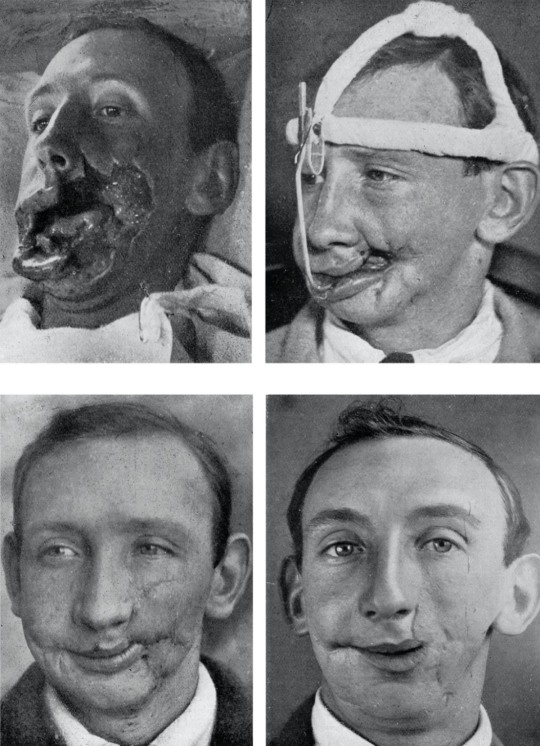
For day #1 I'd like to start with one of my favorite patients in his book Plastic Surgery Of The Face. Case #14 Private Walter Ashworth. In the battle of the Somme, Ashworth received a very extensive cheek wound. Gillies used existing tissue to create a cheek. To create an evenly sized face, he sacrificed lip length. This case is a also great example for early dental prothstetics used to encourage bone growth and early cheek reconstruction.
124 notes
·
View notes
Text
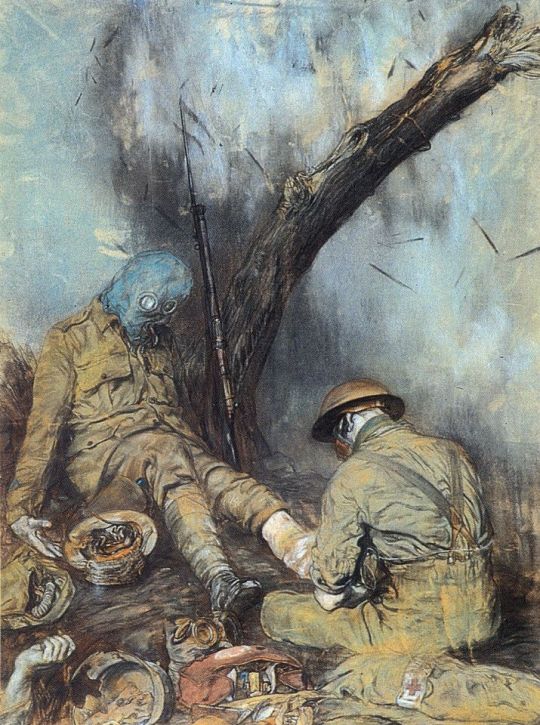
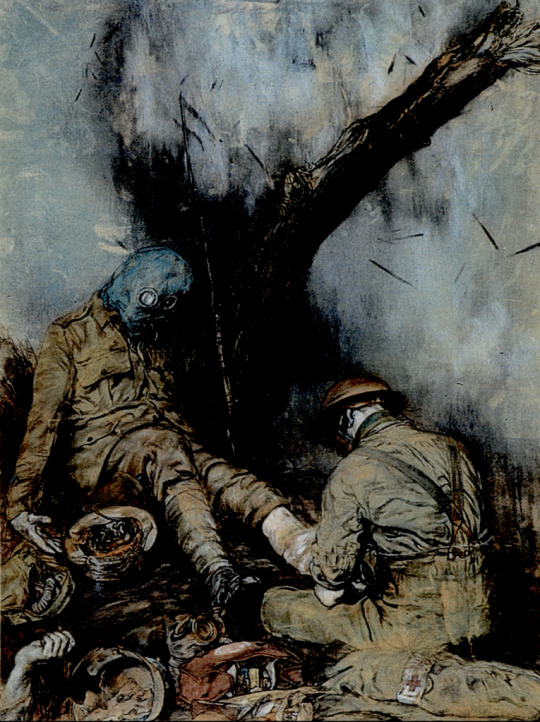
GRIM AFTERMATH OF A GAS ATTACK -- "WAR IS A BLACK HOLE TO AVOID."
PIC(S) INFO: Spotlight on a. WWI-themed art piece titled "Dressing the Wounded During a Gas Attack," pastels on paper/artwork by English artist & occultist, Austin Osman Spare, c. 1919.
Resolution at 765x1023 & 715x960.
IMAGE OVERVIEW: "A wounded British infantryman has his left leg dressed by a man of the Royal Army Medical Corps. Both men wear gas masks as a gas attack is in progress. The wounded man sits beside a bomb damaged tree stump, the RAMC man sitting at his feet with his back to the viewer. The foreground is littered with medical kit, debris and the hand of a dead soldier encroaches into the composition. A shell violently explodes in the background."
-- IMPERIAL WAR MUSEUM (IWM Art Collection)
Sources: www.iwm.org.uk/collections/item/object/25090 & Pinterest.
#Austin Osman Spare#World War I#WWI#Austin Osman Spare Art#World War 1#WW1#Pastels#Pastels Art#Gas Attack#Great War#Dark Art#Chemical Warfare#British Military#Realities of War#Imperial War Museum#Royal Army Medical Corps#1910s#1919#Austin Osman Spare Artist#The Great War#British Army#British Expeditionary Force
42 notes
·
View notes
Text
Doctors were there to manage the workforce, removing workers who were so heavily jaundiced that they were likely to die, and then to obscure the cause of death on certificates and avoid paying compensation where possible.
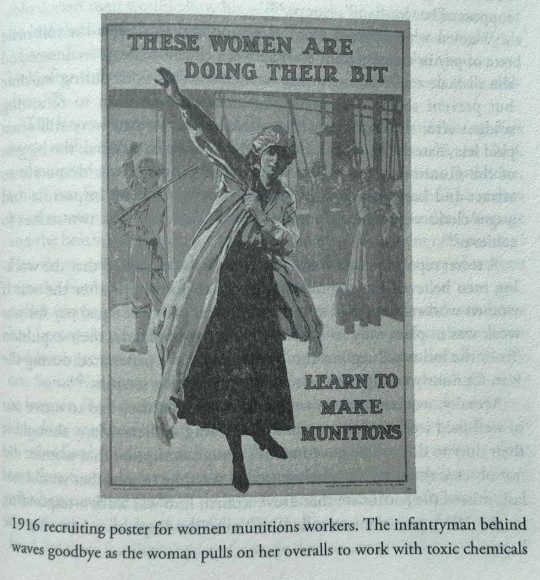
As the war progressed, protective equipment would be issued to munitions workers, and they would be given free milk and subsidised meals to counteract the poison, with shifts reorganised to move women around to give them breaks from the most dangerous areas.
"Normal Women: 900 Years of Making History" - Philippa Gregory
#book quotes#normal women#philippa gregory#nonfiction#munitions#ww1#wwi#world war one#doctors#management#workforce#jaundice#medical malpractice#death certificate#compensation#milk#poison#tnt
3 notes
·
View notes
Note
Sleepover weekend! Hobby you’ve always wanted to get into?
my current hobbies are writing and military drill, so i feel like i could get into anything at this point
i have always wanted to be like really knowledgeable about really specific things. so does research on like one kind of wwi medical practice or knowing everything about clock upkeep or being the leading expert in western films count?
#hello krakerjaksstuff :)#thanks for the ask :3#i am attempting to be the Most Informed on wwi facial reconstruction surgery. it’s hard because i’m not any sort of medical knowing person#but i know a lot. somehow#hmu about military drill. it’s perfect for metaphors for my blorbos
3 notes
·
View notes
Text
i wish i could learn the things i need to learn for my writing without having to read medical journals i do not have the correct brain for reading medical journals
#for context im trying to write a character who is a disabled wwi veteran#but outside of amputations and facial wounds which i guess are straightforward enough for other types of scholars to write about#theres no fucking history-style scholarship about any of it and its all fucking medical journals#and im not smart enough to understand brain or nerve injuries in clinical terms! im not!#i am however overhwelmed#idk. hm. idk man#beck broadcasts
3 notes
·
View notes
Text
i swear i'm always tempted to add an oc nurse muse because i think i don't write any/that many medical muses until i start writing Mccoy and realize just HOW many medical i do actually have. SIX.
#// ooc#technically 7 bc rus was a medic in the army as well but i never do anything w that#well....technically 8 if you want to include tatiana rom.anov bc she was a legit nurse in WWI#no im not including olga for reasons#so actually EIGHT muses#chapel/stevenson/mccoy/luda/morgan and then ofc molly#are the first six#A WHOLE DAMN SUGERY TEAM
2 notes
·
View notes
Note
7 or 22 for the Rook story time ask game?
Going with 7. Rook being taught an important skill!
A New Way to Fight
"Alright, lad, let's see what we're working with." The grizzled old Warden that he'd been dragged out of bed to meet at daybreak grinned at him and asked, "You ever held a sword in your life?"
Ambrose, all of sixteen years old, frowned as he looked down at the wooden training sword that had been thrust into his hand. He could vaguely remember something like it - smaller, blunter, a child's toy - in his hand while his older brother Lawrence grinned at him. That felt like another life now after he'd been given to the Circle in Markham.
Glancing up at the Warden, he replied, "I don't think toys count." The man chuckled in response and nodded slightly.
"Even these old training swords aren't toys," the Warden stated as he picked up another one, turning it so Ambrose could see the base of the hilt. There was an obvious dark spot there and he glanced at the one in his hand to see it was the same. "They're cored with iron and steel so you can get used to the weight of a blade before we put a real one in your hand."
The old veteran then stepped back and folded his arms over his chest, saying, "Swing it 'round and get used to the weight of it first. Then I'll show you the basic drills."
"Drills?" Ambrose questioned even as he swung the sword around, brow furrowed. "Won't I get a staff?"
"You saying that because you're a mage, lad?"
"Well...yes?"
The Warden laughed - a deep, full belly laugh - and stated, "The Wardens don't force our mages to stick to one thing or another like the Circle did, lad. Even if you use a staff, you'll want to have a sword for close combat. Darkspawn will try to kill you no matter what weapon you carry or not."
So will templars, Ambrose thought to himself. His free hand moved at the thought to touch the new scars on the back of his right hand - still pink and shiny with the skin still taut from Liza's last healing on the burns. They certainly hadn't cared when they had shoved him back into the burning building that had then collapsed on him.
The sixteen year-old then stopped, frowning, and asked, "I...won't...won't the leg stop me from fighting?"
The grizzled Warden glanced down at the leather and metal brace that was wrapped around what was left of Ambrose's right leg. That same fire the templars had shoved him back into had burned his leg so badly that they had cut it off. Evrard, a Nevarran-born Warden who was an avid tinkerer, had made it his mission to get Ambrose walking again. With a roughly carved wooden leg as the base and the brace itself bolted to it, he was quickly learning how to get around again.
Abruptly, the Warden shifted his weight and grinned, "There's a reason why they brought you to me, lad." He then pulled the long tails of the grey and blue coat he wore aside to reveal a similar brace around his left leg. As Ambrose stared, he said, "Not a lost limb like yours, but I did lose all feeling in the damn thing. So...close enough. There but..."
"Not there," Ambrose whispered. Sometimes, he woke up feeling like he had an itch between toes that weren't there anymore. Even more than a year after the accident that had led him and the other Markham mages to the Wardens. He then looked at the man and said, "I...Gene didn't tell me your name when he dragged me out of bed for this."
"Marcus, lad," the Warden replied with a broad smile. "Now, how's the sword feel to your arm?"
Ambrose swung the training sword again and smiled awkwardly. "Feel's okay. Heavy but not bad."
"Few years and it'll be easy for you," Marcus commented. "And maybe it'll help you grow into those wide shoulders of yours. Now, come stand next to me, and we'll run the drills until you know how to do them in your sleep."
His leg ached as Ambrose shifted into position, but he'd been feeling one pain or another for more than a year. This one was nothing in comparison and it was worth it.
The encounter with those templars had nearly killed him and he had believed for most of the long healing process that he was going to be permanently crippled. Of course he was but he could still walk. Maybe one day run. And he was getting trained personally by a Warden who knew exactly how to teach him with his handicap.
Ambrose grinned as he followed the old Warden's motions, nodding and making changes when they were pointed out to him. Tighter grip on the hilt. Turn his wrist with the sword to follow the blow through. Learn how to balance on his good leg because in a fight that's going to be his strong point.
He wasn't useless and he wasn't going to be a burden.
He was going to be a Warden.
#dragon age#ambrose thorne#ask answer#i haven't made note of it in either of his other short stories but all versions of ambrose have half a missing leg#his original iteration was a wwi medic injured by artillery#varric's brace actually secured for me that ambrose's personal canon injury was viable#haven’t entirely nailed out the mechanics for it but i have thoughts#this is set during inquistion#little over a year since the start of the mage templar war breaking out in its little skirmishes#he was just a baby mage#fanfiction#warden rook#writing
1 note
·
View note
Text
This is my memorial to my great uncle, LCpl. William Alexander Wyber M.M., 11th Battalion, Royal Scots (1897-1974). I hope this is of interest to those who want to know more about individual soldiers who fought in WWI and what life was like for veterans who suffered from mental health issues after the war.
#wwi#wwi stories#Royal Scots#Clydebank#11th Battalion#mental health#tw: outdated medical terminology#The Great War#1914-1918#Bangour Village Hospital#County Asylums#Historical treatment of schizophrenia#William Wyber
0 notes
Text
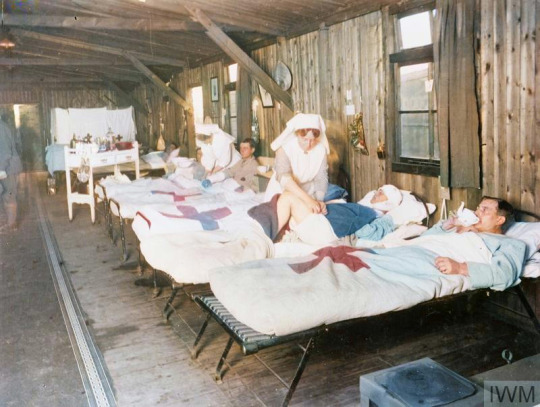
A ward of the 2nd Australian Casualty Clearing Station at Steenwerke, November 1917.
CCS's was the next step in the evacuation chain situated several miles behind the front line, usually near railway lines and waterways, so that the wounded could be evacuated easily to base hospitals.
#the great war#historical photos#world war 1#wwi#the first world war#1917#world war one#history#canadian history#medical history#american history#world history#culture#photo#photography#ww1#world war 1 stories
63 notes
·
View notes
Text
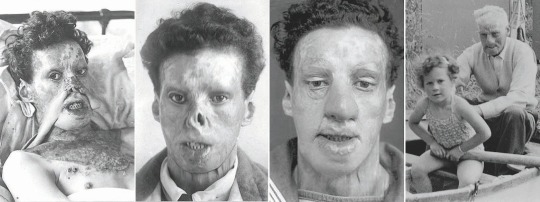
For day #8, I'd like to do William Vicarage. He was another severely burned man at Jutland. This is a particularly revolutionary case because it he was the first patient to receive the Tubed Pedical, which if you don't know, was a skin graft invented by Harold Gillies. It's similar to the traditional flap, but it's stitched into a tube shape before being attached to the sight. This increases blood flow and diminishes the risk of infection. In Vicarages case, two V like grafts were taken from his chest and placed onto his cheeks, as seen in the first picture. The poor man had no lips or eyelids, and it took many surgeries and grafts to get him functional again, but as you can see In the last picture with him as an old man, he was infact returned to his former self, and lived a long and happy life.
15 notes
·
View notes
Text
i think there should be more movies about living through the great depression i think they would be really interesting and resonant.
#we have grapes of wrath sure but what else??#historical fiction is so focused on wars and biopics and i get it i do there are Stories and Narratives there#war movies esp wwii movies are about Heroism and Patriotism and Sacrifice and there's Action and Good Guys and Bad Guys#biopics also have kind of an in-built narrative and if there's one thing popular history loves to do it's narrativize history#but there are narratives to be found in the lives of real people living through big events.#a romance set in the great depression would be a human story about finding love and happiness in the midst of turmoil and fear#a medical drama set during the spanish influenza could be a man vs nature story about helping people in the face of impossible odds#along the same lines why don't we have movies about nurses during the world wars i want movies about nurses during the world wars so badly#anything about women in war would be nice we never get to be in war movies#in one of my uni classes we read ab excerpt of a memoir this guy wrote about his parents who were both wwi veterans#and the trouble they had reacclimating to civilian life like obviously his father (a soldier) was shell-shocked#but more interesting TO ME was his mother who had been a nurse and had experienced independence and respect for the very first time#and she was also traumatized by yk The Horrors but she also seemed to yearn for it#i think she eventually got a job at the local veterans hospital because she just couldn't bring herself to stay home#and wouldn't that make a great family drama????? i'd watch the hell out of that
1 note
·
View note
Text
I’ve read so many stories from WWI about how wounded soldiers who couldn’t be taken to a hospital and got infected with maggots had a higher survival rate and healed up nicer than a lot of soldiers who were cared for by doctors because the maggots were far better at removing dead/rotten tissue and leaving healthy tissue intact that if I was far from medical care and ended up with maggots in my wound I’d kick anyone away who tried to remove them “No! Let them work!” Fuck, if I was offered to be treated with the modern maggots bred specifically for wound treatment at a hospital I’d be kinda excited. And if someone else got a maggoty wound far from civilization and freaked out I’d try my damn hardest to convince them to please leave them in.
But try having a normal conversation with someone at a dinner party about that.
2K notes
·
View notes
Note
Just gift army vampire bf medical textbooks and show him how advanced in some aspects the medical word has come since WWI 😂
Oh my god hahahaha. I can imagine this going two ways. Either the good way where he totallyyy nerds out and gets obsessed with medicine, wondering why they didn’t teach this to him. Or the bad way where it makes him worry for reader more. I wrote the bad way lmao
As much as you loved having Army Medic Vampire bf dote on you as you were sick, you could tell his worry was beginning to consume him. And for now you were only human so eventually his squeezing got so tight you ended up not being able to breathe.
Which of course sent you into another coughing fit.
So in order to assuage your immortal lover, you thought it would be a good idea to introduce him to something a little more modern. Sticking him in front of the computer, an object he already struggles with, you bring up one website in particular.
The National Library of Medicine.
Of course, he makes a fuss about checking it out for your sake but that he doesn’t really trust it given the website belongs to the U.S. government. All its credibility flew out the window when he saw that little tid bit.
Instead you pull up The Royal Society of Medicine Library and let him have at it. The only issue is that you haven’t seen him since.
Hours have passed and you haven’t heard a peep from him. Given his undead state that’s not exactly cause for concern. Yet something about it feels off anyone. Ignoring the dizzy spell that washes over you when you stand, you weakly make your way out to the living room.
Only to see Army Medic Vampire bf pacing around the room, hastily slamming and locking all the windows closed and checking the temperature. His long blonde hair and fussed up and his red eyes nearly wild with insanity.
“What’s going on?!” You call out to him and oh you almost regret it.
His head snaps over to you and when one second he was at the opposite side of the room he’s now in front of you, scooping you back up into his arms. Holding you tighter than ever before.
“There’s so much disease! Sickness. Why didn’t you tell me?! So much I didn’t know, wasn’t aware of. Every little thing can so easily bring down a mortal!” He rambles on and on like a man possessed.
Carrying you back into the bedroom where you can rest, he curls his body around you. Making his body act as a shield from the world of germs constantly surrounding you. You help soothe him where you can and you feel him petting the back of your head.
“My immune system does what it can, you know,” you mumble into his neck, knowing how shaken he must be to tuck you into such a vulnerable spot for him.
Army Medic Vampire bf immediately shakes his head. It wasn’t enough. Everything about a human was so fragile, he had forgotten that before meeting you. And ever since he’s remembered it’s terrified him.
“It too is puny and weak, look at you already on deaths door. Practically skin and bones,” he complains dramatically, a small pout on his face.
You send him a playful glare but he either doesn’t notice or purposefully ignores it. You suspect the latter given the way he immediately tucks you back into his neck.
“No matter. The moment you are better we’ll never have to worry about such things again. A gift of being immortal.”
“Right. Then I’ll only have to worry about the sun, holy water, wooden stakes, and fire,” you snap back.
Amused for only a moment before your bf is squeezing the life out of you. A wide horrified look on his face. Realizing there will never come a day where he’ll stop worrying over your safety.
“Oh Gods.”
#dragonsasks#monster fucker#monster lover#monster romance#monster fluff#monster fic#monster imagine#monster boyfriend#monster bf#vampire fucker#vampire lover#vampire romance#vampire fanfiction#vampire imagine#vampire boyfriend#vampire#x chubby reader#x reader#vampire x reader#vampire x human#vampire x you#vampire x y/n#monster x reader#monster x human#monster x chubby reader
174 notes
·
View notes
Text
TF2 in Historical Context: Spy's Background
It goes without saying that Spy is incredibly mysterious and we know fuck all about him, other than that he at some point had an affair with Scout's mother, and Scout was the product of that. However, I think we can extrapolate some stuff about his backstory nonetheless

Firstly, we learn in Comic 6, which takes place in 1972, that Scout is 26-27 years old. This puts his birth year at 1945 or 1946, right after the end of WWII. I say '26' bc uh. Babies gotta grow yk

This puts Spy's latest possible birth year at around 1927. Probably a little (but not much) earlier, for reasons we'll get into. It is fair to assume that Spy was already a spy by the time he met Ma, because there's no other reason for him to have been in Boston in 1945 really


I can't be the only one who was kinda surprised that Spy looks much younger than I expected without his mask - he's less noticeaby greying than Heavy and Medic too. He's either got an insane botox routine (which wouldn't be ooc lol), or he's younger than the two of them.
In my last post I concluded Heavy was around 52 in 1972, and 59 in 1979. If Spy is slightly younger, that would make him in his mid 40s in game, late 40s in Comic 6 and early to mid 50s in Comic 7.
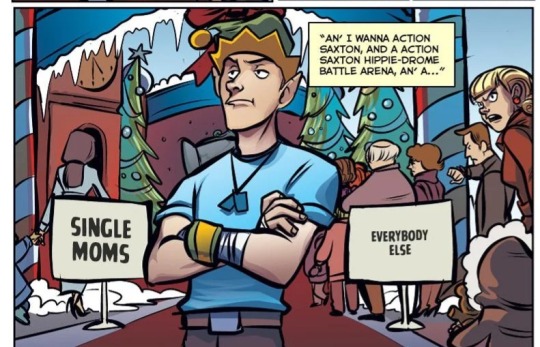
So. Given Scout is 27, that means that Spy would have met Ma when he was in his early 20s. On a related note, given she already had 6 children before they met, she's also probably quite a bit older than him lol. Seems like both he and Scout have a thing for Moms
All this to say, I think 1924ish is a good approximate birth year for Spy. This would make him 15 years old when WWII broke out and just 16 when Germany invaded France in 1940.
Onto historical context: France was the first modern nation in Western Europe to introduce universal military conscription, which wasn't phased out until 2001. Conscription did take place during WWII (and WWI), but Spy was almost definitely too young to be drafted.
We don't know which region of France Spy is from, so we don't know whether he grew up in the zone libre, which was free from Nazi occupation, or in Vichy France, the puppet state headed by Maréchal Philippe Pétain established by the German occupying force.
Given Spy's age and the context of the Nazi occupation of France, I think it's most likely he entered the world of espionage by joining the French Resistance. Resistance fighters were highly diverse and came from different sections of society, but young people were esp useful.
After the war, a national myth arose in France that overplayed the size and breadth of the Resistance forces, whilst underplaying or ignoring the degree of collaboration of some parts of the country with the Nazi occupation. This came to be known as Résistancialisme.
Something I always think about with the European mercs is the question of how they ended up in the USA in the first place. Given Scout was born around ~1945, Spy must have left France after it was liberated in September 1944.
I feel like if Spy were a member of the Resistance, this shift in the collective memory of the resistance in France may have been one of the reasons he left the country. Either that or he found himself good at working undercover and fell into working internationally.
170 notes
·
View notes